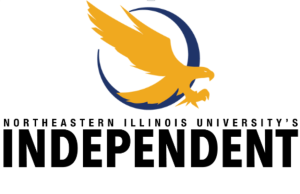“Forbidden Art” – Death Camp Art at NEIU
October 3, 2012
Birkenau Mieczyslaw
Inside a male barrack by Birkenau Mieczyslaw
Czesław Lenczowski
Phantoms are back Czesław Lenczowski
Oświęcim Jerzy Adam Brandhuber
Wheel-barrows from the cycle I
Halina Ołomucka
Before selection
Jerzy Potrzebowski
Loading sick people on car
How does one portray the hell of the Auschwitz death camp? By letting the victims who experienced it tell their own story through artwork. The highly popular temporary exhibition “Forbidden Art,” previously exclusively shown in Poland’s Auschwitz-Birkenau State Museum, has arrived in the United States. It contains camp prisoners’ works made illegally under the threat of death. On its journey through the country it makes a stop at Northeastern Illinois University (NEIU), and is on display now through Oct. 20 on the second floor of the Student Union.
The exhibition’s United States premiere took place at the Polish Mission in Orchard Lake, Mich. Over the next months it will travel the U.S. and will be shown in two academic centers in Illinois: NEIU and Wayne State University. The exhibit will also be shown at the public University of California, UCLA and the Kosciuszko Foundation in New York. NEIU’s exhibition is organized by the University Office of International Programs in cooperation with the Polish Mission.
The exposition shows artwork made by prisoners of the Nazi German concentration camps created during WWII in Europe that imprisoned and led to the cause of thousands of Jews and Slavic people. “Many artists were imprisoned in Auschwitz. While some of them produced art with the Nazis’ approval, others risked their lives trying to record horrors of the camps and leave a testimony for future generations,” Wojciech Wloch from NEIU Office of International Programs said. Hitler favored classic art or beautiful pictures, as opposed to realistic drawings depicting life in the camps. The prisoners, forced to conceal their artwork, showed their courage by simply producing it.
The exhibition is divided in two parts. The first shows the camp’s reality – scenes from its functioning and portraits of prisoners. The second presents some ways of escape from this reality: caricatures, albums with greetings and fairy tales that prisoners wrote for their children. The works are shown in photographic form. They are diverse, but according to the exhibition’s curator and art historian of Poland’s Auschwitz-Birkenau State Museum Agnieszka Sieradzka, one thing connects them: “Each of them is a moving story of a particular human being, created at the risk of life and which is today a testimony, document and personal confession.”
“It’s worth it to see the exhibition twice,” added Wloch. “During the daytime as well as in the evening. Each time it will have a[n] unique climate triggering different emotions.”
“Forbidden Art” will be accompanied by education and information sessions, workshops and lectures.On Friday Oct. 5, from 10-10:50 a.m., during a Sociology of Racism class a lecture by Krystyna Oleksy Executive Director of the Memorial Foundation for the Victims of Auschwitz-Birkenau will take place on the German death camp Auschwitz. To take part in the lecture, contact Mr. Wloch, room 8A at LWH.The Third Annual Conference on “Art in Response to Violence” will take place on Oct. 18 and 19. While a registration and fee is required for the conference, attendance for a panel discussion on Auschwitz-Birkenau is free and takes place on Oct. 18 at 9.30 a.m.





